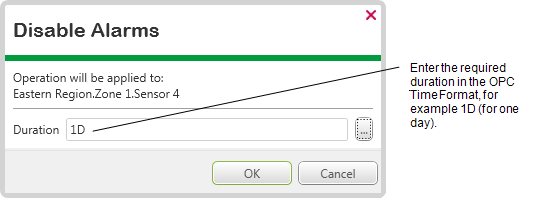In the server configuration, there is a Variable Duration setting for Disable Alarms. The Variable Duration sets the Disable Alarms action to be in effect for an amount of time that is defined by the user or included as a parameter (in a Logic program Schedule action etc.). The item’s alarms and alarm actions will only be re-displayed when the user-defined VariableDuration expires or when the Enable Alarms action is triggered.
When Variable Duration is used, the Disable Alarms action works like this:
- The Disable Alarms action for an item is selected by a user or triggered by a Schedule, Logic program or Method Call. The item could be an individual database item or a Group.
- The time period is defined.
- If a user selects the Disable Alarms action, ClearSCADA prompts the user to define the time period. The user enters the required amount in the OPC Time Format and selects OK.

For information about the OPCTime Format see OPC Time Format in the ClearSCADA Guide to Core Configuration.
- If a Logic program, Schedule or Method Call triggers the Disable Alarms action, the amount of time has to be defined as a parameter (in the Logic program, action, and so on).
NOTE: When Independent is enabled, Logic, Schedules and Method Calls cannot apply a duration when disabling alarms. Only users can trigger Disable Alarms with a duration. When Independent is disabled, any specified duration is applied, irrespective of the User Type that triggers the Disable Alarms action. For more information on Independent, see Define whether User Types can Disable Alarms Independently in the ClearSCADA Guide to Server Administration.
When the item’s alarms are disabled, ClearSCADA:
- Assigns the Alarm Disabled system color to the item. The color is used on displays such as Queries Lists, unless another color status takes precedence.
- Will not display alarms for the item
- Denies access to the alarm response actions (Acknowledge, Unacknowledge, and so on.)
- Will not redirect alarms for the item (if any redirections are configured)
- Logs the item’s change in state in the Event Journal (Events List). This will not appear as an alarm-related entry as no alarm has been generated.
- Indicates that the items alarms are disabled on the item’s Status display. ClearSCADA continues to monitor the item for alarm conditions, but does not display any alarm information. ClearSCADA will only display the alarm details when the item’s alarms are no longer withheld (are enabled).
- If a user selects the Disable Alarms action, ClearSCADA prompts the user to define the time period. The user enters the required amount in the OPC Time Format and selects OK.
- ClearSCADA continues to monitor the item for alarm conditions, but does not display any alarm information. ClearSCADA will only display the alarm details when the item’s alarms are no longer withheld (are enabled).
- The item’s alarms and alarm features continue to be withheld until:
- The Variable Duration expires. For example, if a user defined a duration of 8H, the Disable Alarms action could withhold the item’s alarms for a maximum of 8 hours. After 8 hours, the item’s alarms are re-enabled.
NOTE: If the Independent setting is enabled on the server, at the end of the Duration, the User flag changes from Disabled to Enabled. Whether this means that the item’s alarms become enabled is still dependent on the flags for the Logic, Schedule and Method Call User Types (that is, these flags may be reset to ‘enabled’ independently).
Or:
- The Enable Alarms action is triggered by a user, Logic program, Schedule or Method Call. The Independent setting on the server has an effect on how the Enable Alarms action works (see Define whether User Types can Disable Alarms Independently in the ClearSCADA Guide to Server Administration).
- The Variable Duration expires. For example, if a user defined a duration of 8H, the Disable Alarms action could withhold the item’s alarms for a maximum of 8 hours. After 8 hours, the item’s alarms are re-enabled.